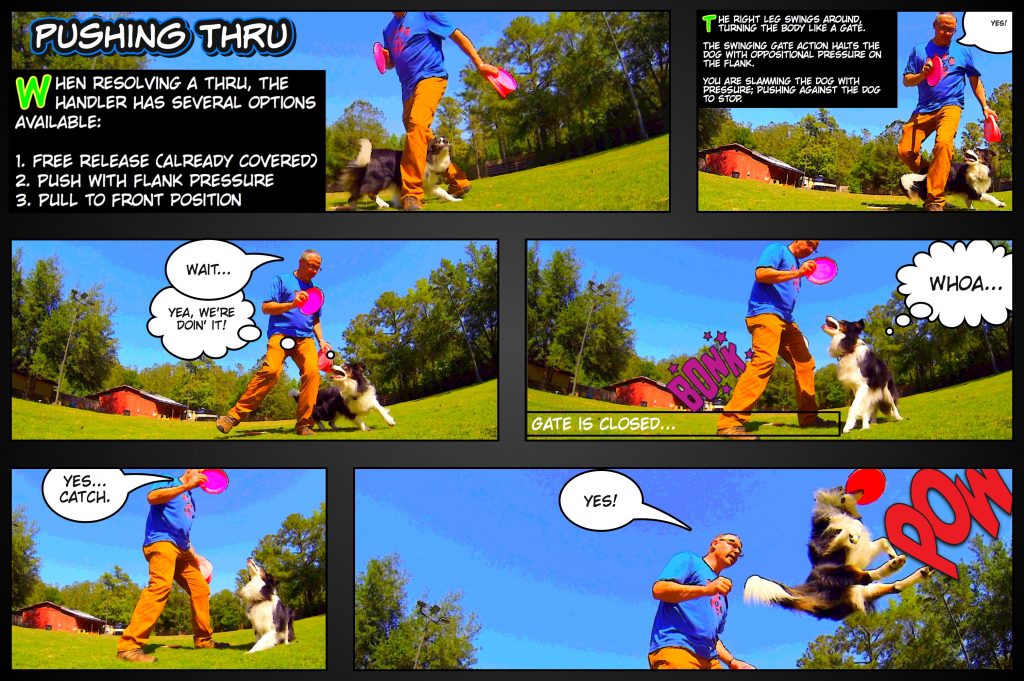
Anatomy of a Disc Dog Sequence: Through… Wait… Flip
The foundational sequence at Pawsitive Vybe, Through… Wait… Flip! is the move that we suggest people start exploring sequences with. It is super easy to do, which is great, and it affords a wonderful opportunity to explore many aspects of Team MovementTeam Movement is how dog and handler move, as a team, out there on the field. It is a judging category in some organizations and certainly is a focus of many judges, players,... More. Because while Through… Wait… Flip! is an easy and simple sequence, it’s a bit less simple once we break it down and really take a good look at it, but it’s still easy.
Through: Clock or Counter?
The Through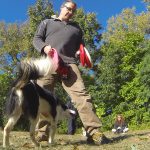 A Through is a set up move where the dog runs between the handler’s legs. The dog can move from front to back or side to side and can even weave. A Through... More behavior, just like the AroundAn Around, or a Go Around is the traditional disc dog set up move. The dog goes around the handler’s body in a clockwise or counter clockwise fashion allowing dog and handler to... More behavior, has a clock and counter clockwise direction. If the dog goes through and exits or drifts out to the handler’s left, from 7 to 12 o clock, then it is a Clockwise Through. If the dog exits the Through to the handler’s right, towards 5 to 1 o clock then it is counter.
A Through is a set up move where the dog runs between the handler’s legs. The dog can move from front to back or side to side and can even weave. A Through... More behavior, just like the AroundAn Around, or a Go Around is the traditional disc dog set up move. The dog goes around the handler’s body in a clockwise or counter clockwise fashion allowing dog and handler to... More behavior, has a clock and counter clockwise direction. If the dog goes through and exits or drifts out to the handler’s left, from 7 to 12 o clock, then it is a Clockwise Through. If the dog exits the Through to the handler’s right, towards 5 to 1 o clock then it is counter.
Think of luring your dog through with your hand, the left hand will pull the dog through and finish in Basic Flatwork Position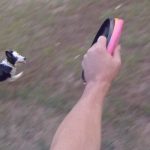 Basic Flatwork Position (BFP) is a standard position of the handler in the Working Flank; hand reaching out towards the dog (usually with a disc) with the dog on the same plane as... More (BFP) Clock on the Clockwise Flank
Basic Flatwork Position (BFP) is a standard position of the handler in the Working Flank; hand reaching out towards the dog (usually with a disc) with the dog on the same plane as... More (BFP) Clock on the Clockwise Flank Out to the side of the handler is the Flank. If the dog is out to the handler's right or left the dog is on Flank. If the dog is moving with the... More. To pull the dog through counter clock, it will be the right hand luring the dog. This is simple Flatwork
Out to the side of the handler is the Flank. If the dog is out to the handler's right or left the dog is on Flank. If the dog is moving with the... More. To pull the dog through counter clock, it will be the right hand luring the dog. This is simple Flatwork Flatwork is the stuff that happens between the catches. How the team moves and transitions, often without the disc, is flatwork. Flatwork concepts in disc dog are taken from the agility and herding... More.
Flatwork is the stuff that happens between the catches. How the team moves and transitions, often without the disc, is flatwork. Flatwork concepts in disc dog are taken from the agility and herding... More.
In addition to the hands, the feet play a role in cuing the intended direction of the Through, clock or counter. Follow the Laws of Flatwork and you’ll be great.
Stepping back or stepping laterally is key because stepping forward, or using the wrong foot will create an unintended pressure that will make the dog unlikely to pierce the handler’s plane and can push the dog in the opposite direction. Also, notice the toe turn…
Team Movement vs Free Release
If the dog finishes a trick and releases or moves independent of the handler we consider it a Free Release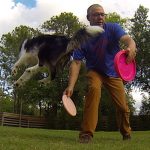 Release has many meanings in disc. Throws and throw variations can be referred to as releases. Sometimes you talk about the dog releasing something, the toy, or the environment, as in to stop... More. You can have Team Movement or a Free Release, but you can’t have both. A Through with a crazy toss to a free releasing dog should only get the Team Movement score of the Through behavior. The subsequent pattern after the through might look cool, but it ain’t really Team Movement unless the handler does something to interact with the dog.
Release has many meanings in disc. Throws and throw variations can be referred to as releases. Sometimes you talk about the dog releasing something, the toy, or the environment, as in to stop... More. You can have Team Movement or a Free Release, but you can’t have both. A Through with a crazy toss to a free releasing dog should only get the Team Movement score of the Through behavior. The subsequent pattern after the through might look cool, but it ain’t really Team Movement unless the handler does something to interact with the dog.
A well executed and handled Through behavior sees the dog and handler in contact and communication at the start and finish of the through. The free release version of the Through is not the same level of Team Movement as a well handled Through. The well executed Through allows the handler to choose the release and resolution of the trick instead of relying on the dog’s natural or conditioned predilections and looks connected; you know, like a team.
Epic gets caught up on this on the Counter Clock Through. He’s resolving the sequence on his own without the handler. He knows what’s coming so he’s breaking contact with the handler to get in the position he thinks we should be in.
Handling the dog throughout the Through is the very definition of Team Movement; dog and handler moving together, as a Team. Resolving the trick in the Team’s best interest is also a huge benefit/requirement of Team Movement.
The Chain of Events
With a disc in each hand in BSPStanding in front of the dog with the disc held vertically in the throwing hand is Basic Standing Position (BSP), a foundational position in the Yachi Method. More Counter, the handler verbally cues Through, then opens legs, stepping back and left a bit with the left foot, creating the through gap and counter clockwise, sucking pressure. The right hand then pulls the dog through in a counter clockwise direction. Each of these cues reinforce each other. The weakest cue, the verbal, is followed by a stronger cue, the legs opening and pressure effect. The flashing hand, is pretty much just piling on and staying connected for the next stage of the trick.
The dog is Through, attached to the lure of the disc attached to the handler’s right hand, moving on a Counter Clock Flank. Now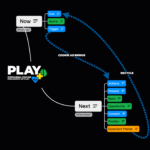 The Now Phase is an integral part of the Play Cycle in the Play+ training philosophy. It embodies the current, immediate interaction between the handler and the dog, anchoring them in the present... More it’s time for the Front Cross
The Now Phase is an integral part of the Play Cycle in the Play+ training philosophy. It embodies the current, immediate interaction between the handler and the dog, anchoring them in the present... More it’s time for the Front Cross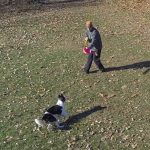 On a Front Cross, your dog switches Flanks in with you in front of them. From Clock to Counter Clockwise Flank or vice versa. Taken directly from the canine agility world, the Front... More to stop the dog’s Counter Flank and get set in Front
On a Front Cross, your dog switches Flanks in with you in front of them. From Clock to Counter Clockwise Flank or vice versa. Taken directly from the canine agility world, the Front... More to stop the dog’s Counter Flank and get set in Front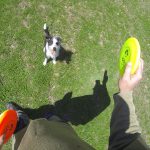 Front is a stable position directly in front of the handler. Front is an traditional obedience skill. Usually your dog sits in this position, but standing is often acceptable as well, especially in... More PositionIn the Play+ philosophy, "Position" is the final stage within the "Next" phase of a Cycle of Play. It acts as a pivotal link between the "Next" phase and a new "Now" phase. More for the Flip.
Front is a stable position directly in front of the handler. Front is an traditional obedience skill. Usually your dog sits in this position, but standing is often acceptable as well, especially in... More PositionIn the Play+ philosophy, "Position" is the final stage within the "Next" phase of a Cycle of Play. It acts as a pivotal link between the "Next" phase and a new "Now" phase. More for the Flip.
The handler turns clockwise and move the disc filled left hand to match the right while pointing at the dog. The dog should start to shift directions with the handler and attach to the left hand on the clockwise flank. The handler’s feet will change to a clockwise stance (left foot forward) at this time; it’s the way of the Front Cross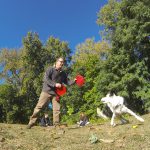 A Cross is an canine agility term that describes a change of working sides. Your dog moves from your left to your right (Heel to Side) or from Clock to Counter. Crosses are... More. Shift your feet to a counter clock stance (right foot forward – perhaps another Front Cross) and your dog should be locked in for the Flip.
A Cross is an canine agility term that describes a change of working sides. Your dog moves from your left to your right (Heel to Side) or from Clock to Counter. Crosses are... More. Shift your feet to a counter clock stance (right foot forward – perhaps another Front Cross) and your dog should be locked in for the Flip.
Breaking Down the Chain
The verbal cue is a pre-cue. It asks the dog to be aware that there is a Through opportunity in the works. BSP Counter establishes the counter clockwise line. The legs opening is the physical cue which confirms the pre-cue and gets the ball rolling. The hand flashing of the disc speeds the dog along and sets up our connection via BFP and the Front Cross. The feet shift from counter to clock at the same time as the BFP cues change; pointing at and orienting these changes to the dog is part of connection – think Flatwork.
Once the hands meet and the feet shift, the dog has moved from the Counter to the Clock Flank. To truly halt the dog, a bit of a finagle of a stance shift to Counter Clock might be necessary. This may or may not require an additional Front Cross.
So we have verbal, physical, BFP for connection and confirmation, the Front Cross featuring orchestrated positional pressure and the hands and feet, maybe a second Front Cross, then Flip.
The Essence of Team Movement
The point of this piece was not to bog you down in details, but to draw attention to all the foundational skills being expressed in the easiest of disc dog freestyle sequences. We use this sequence for teaching for a reason; it’s got a lot of angles to work – cuing, stance, pressure, marking, wait, etc. It’s a strong foundational sequence for Team Movement and a great sequence for teaching. It can be purposed in so many ways. I use it myself to explore movement with my dog and to exercise team movement frequently.
This same concept: cuing properly, working the dog during the skill, paying attention to direction, picking them up momentarily in flank, front crossing for angle, position, and timing can be used in all sequences. On vaults and overs, especially. Transitions are ripe for this kind of expressive Team Movement.
Check out the Disc Quan Do Red Belt Balanced Position Form.
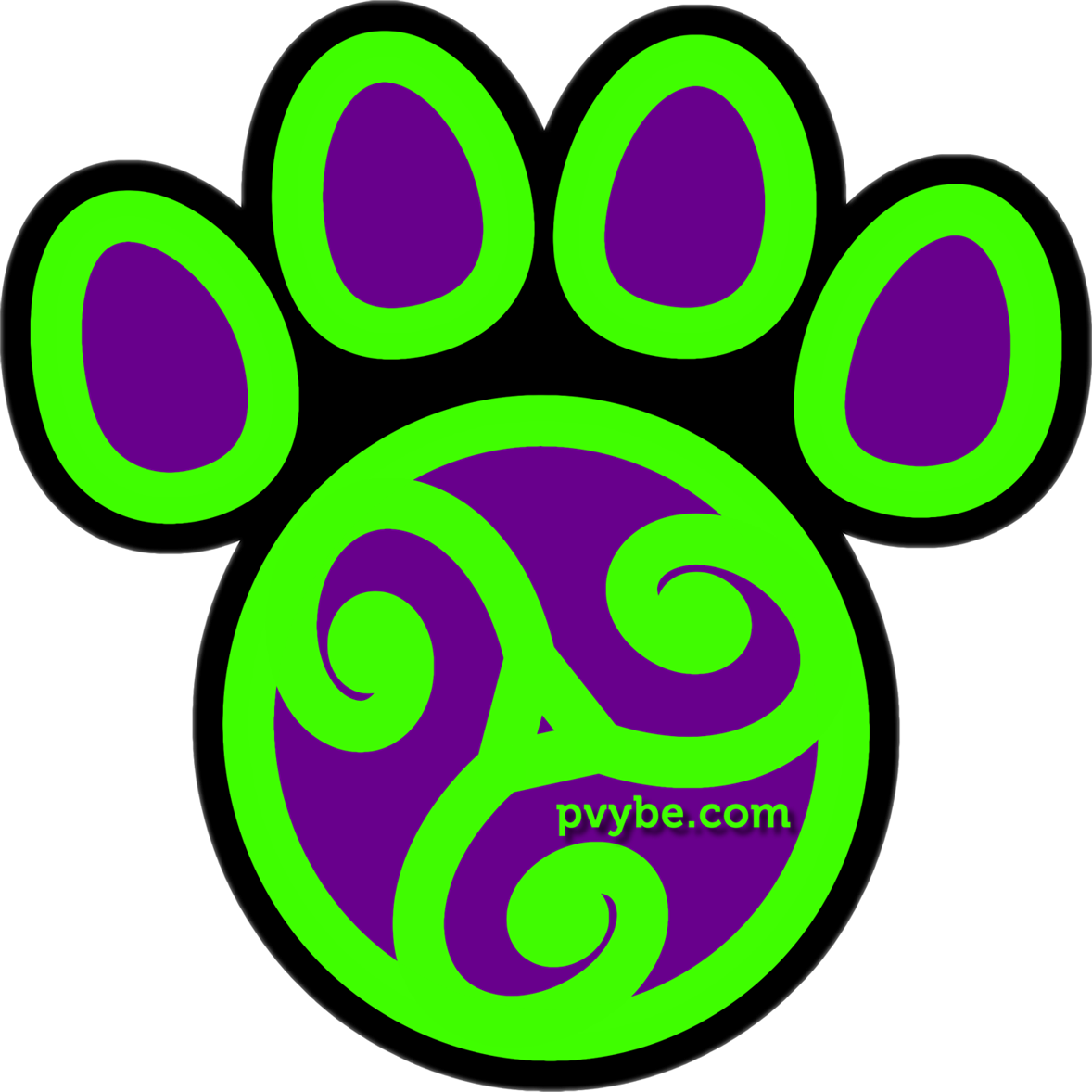


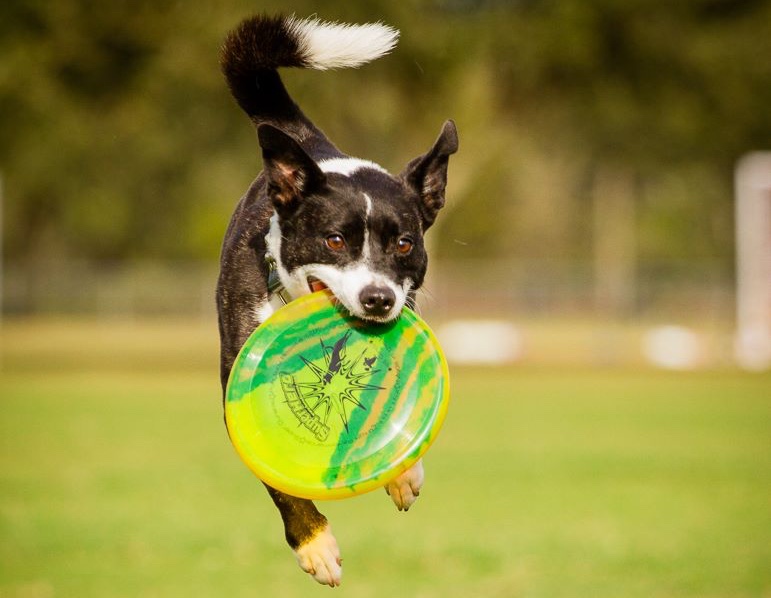
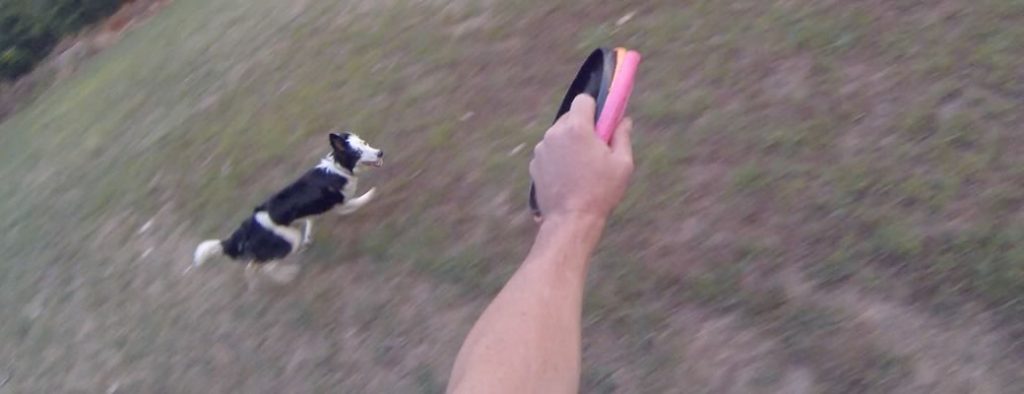

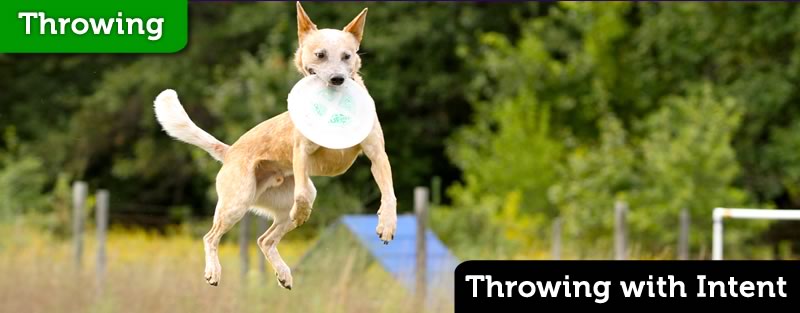
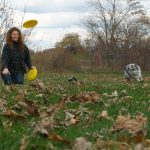
Responses